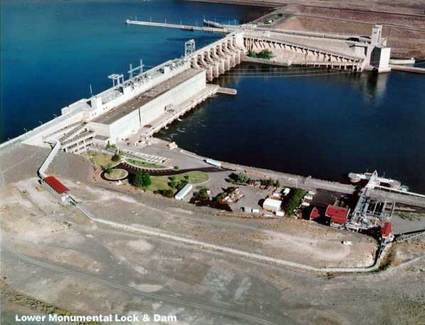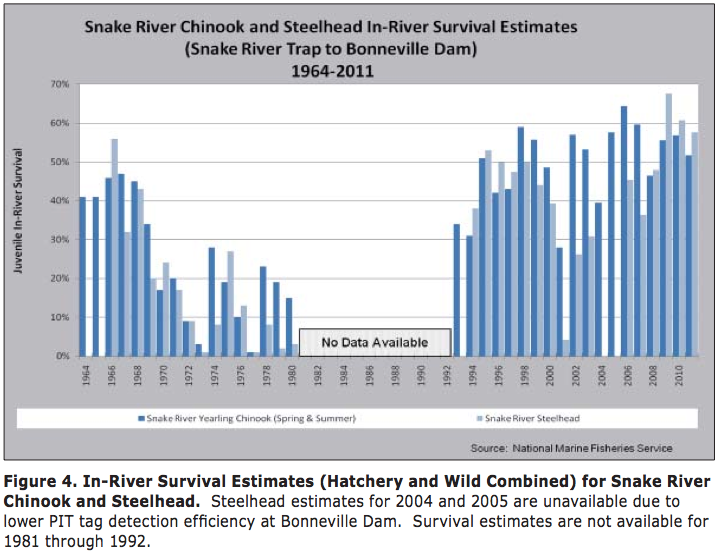forum
library
tutorial
contact

Idaho Needs and Can Maintain
Both Its Dams and Fish
by David Doeringsfeld
Lewiston Tribune, March 15, 2015
|
the film forum library tutorial contact |

|
Idaho Needs and Can Maintain
by David Doeringsfeld
|
 The Lewiston Tribune has recently provided a platform for Jim Waddell's criticism of the Army Corps of Engineers' 2002 Lower Snake River Juvenile Salmon Migration Feasibility Report/Environmental Impact Statement (FR/EIS) as evidence that the original study was seriously flawed. While Waddell is certainly entitled to his opinion, we cannot overlook the comprehensive review of the 2002 FR/EIS.
The Lewiston Tribune has recently provided a platform for Jim Waddell's criticism of the Army Corps of Engineers' 2002 Lower Snake River Juvenile Salmon Migration Feasibility Report/Environmental Impact Statement (FR/EIS) as evidence that the original study was seriously flawed. While Waddell is certainly entitled to his opinion, we cannot overlook the comprehensive review of the 2002 FR/EIS.
The corps was the lead federal agency for the six-year, $30 million study, which was intended to be a thorough review of the best science regarding the impact of the lower Snake River dams on salmon and steelhead recovery.
The National Marine Fisheries Service, U.S. Fish and Wildlife Service, Bonneville Power Administration, tribes, state fish and game agencies, environmental organizations and the public were all involved in the preparation and review of the study.
As with any study of this magnitude and interested parties, there were inevitable disagreements. Yet, everyone had an opportunity to comment.
In the end, the corps made a recommendation based on input compiled from 9,000 participants consisting of federal and state agencies and the public. The corps' final recommendation was reviewed by the Drawdown Regional Economic Workgroup.
Nearly 14 years later, Waddell now suggests that he was a lone voice skeptical of the 2002 study. He would have us discard effective fish passage improvements and immediately breach dams.
(bluefish notes: Waddell was far from being a lone skeptic of the study. See for instance Oregon Joins Lawsuit Accusing BPA Of Hurting Fish The Columbian, 1/18/2)
The absolute certainty that dam breaching will be a "silver bullet" for improving fish runs is disingenuous. So many other factors, such as predation, harvest, habitat, ocean conditions and climate change are more impactful on salmon returns than dams.
Where is the independent peer review of Waddell's claims? The Lewiston Tribune has repeatedly published his comments in the front page, the editorial page and numerous articles as if they were fact. Is this responsible journalism?
 There are two basic facts which Waddell cannot dispute:
There are two basic facts which Waddell cannot dispute:
Container volumes at the Port of Lewiston have fallen substantially due to management/labor issues at the Port of Portland.
In a recent editorial, the Lewiston Tribune failed to note that bulk wheat shipments by Lewis Clark Terminal at Lewiston are at historic levels. Singling out decreased container volumes while ignoring the main source of tonnage on the system - Northwest-grown wheat - is hardly a justification to tear out dams and end commercial navigation, the most efficient and environmentally friendly form of cargo transport.
(bluefish notes: River lockages cost $1 million per year in foregone power, a cost not borne by the shippers for the benefit they receive from the lifting. See Electric Power Foregone to Lock Flush by Oregon Natural Resource Council Restoring the Lower Snake River, Appendix to Section 2)
The economy of north central Idaho is based on agriculture and timber - two industries that will be in high demand with a growing world population.
Without inexpensive, direct access to the Washington and Oregon ports via barging on the Snake and Columbia rivers, Idaho grain farmers will lose their competitive edge in international markets.
Without clean, renewable and consistent power generated by the Snake River dams, our region will have to invest in new power plants to provide backup generation.
We need to stand up as a region and recognize the multi-purpose benefits the Columbia/Snake River System continues to provide to the state of Idaho and the entire Northwest.
For more information, please visit www.snakeriverdams.com or www.portoflewiston.com.
Related Pages:
Waddell is Not So Easy to Ignore by Chris Carlson, Lewiston Tribune, 2/27/15
Will Taxpayers Dub It a 'Port to Nowhere'? by Marty Trillhaase, Lewiston Tribune, 4/1/15
Feds' Five-Year Check-In: Most ESA-Listed Fish Increased in Abundance Since 1990s by Staff, Columbia Basin Bulletin, 7/12/13
Mainzer Tells Power Council that Bonneville Will Meet its Energy Efficiency Targets by Ted Sickinger, The Oregonian, 3/11/14
NW Utilities Continue to Meet Energy Efficiency Targets Set by NW Power Council by Staff, Columbia Basin Bulletin, 1/17/14
learn more on topics covered in the film
see the video
read the script
learn the songs
discussion forum
